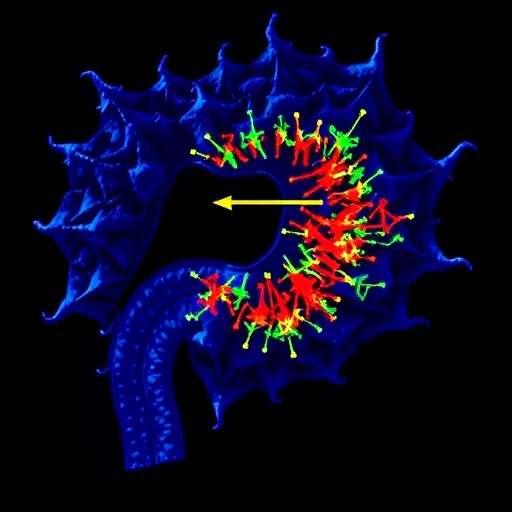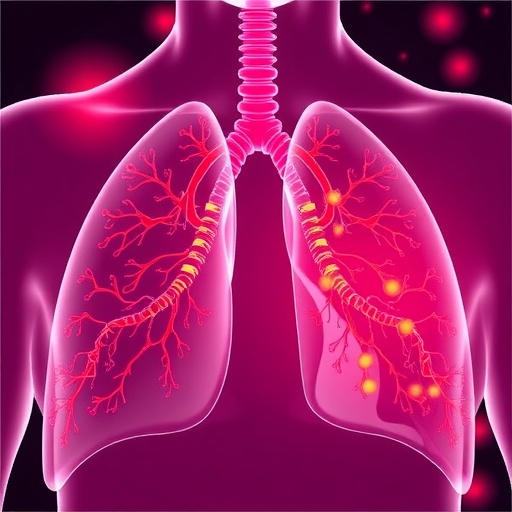In a groundbreaking advancement for pancreatic cancer prognostics, scientists have unveiled a novel, non-invasive biomarker that holds promise for predicting patient outcomes in advanced pancreatic ductal adenocarcinoma (PDAC). The study centers around the proteolytic degradation of the extracellular matrix protein Beta-Ig H3 (βigH3), also known as transforming growth factor β induced protein (TGFBI). By quantifying a specific collagenase-generated fragment of βigH3 in human serum, researchers have opened the door to new avenues for cancer prognosis that could significantly impact clinical decision-making.
Pancreatic ductal adenocarcinoma remains one of the deadliest cancers worldwide due to its late diagnosis and limited therapeutic options. Traditionally, prognosis relies heavily on clinical staging and biomarkers like carbohydrate antigen 19–9 (CA19-9), yet these have limitations in sensitivity and specificity. The extracellular matrix (ECM), an intricate network supporting tissue architecture, has increasingly been recognized as a critical player in tumor progression, yet its components have rarely been targeted for prognostic biomarker development—until now.
Beta-Ig H3 (βigH3/TGFBI) is a secreted ECM protein induced by TGF-β signaling pathways, which are often dysregulated in cancer. Prior research established correlations between elevated βigH3 expression and poorer prognosis in PDAC patients. However, the significance of βigH3 degradation fragments in circulation and their association with clinical outcomes remained unexplored. The latest study addresses this gap by developing an innovative enzyme-linked immunosorbent assay (ELISA) targeting the N-terminal fragment of βigH3, spanning amino acids 1 to 137, generated through collagenase activity.
The ELISA assay demonstrated high specificity for this cleaved fragment—referred to as cβigH3—excluding interference from intact βigH3 or other structural isoforms. Validation experiments confirmed that cβigH3 originates from the proteolytic fragmentation of fibroblast-generated ECM, particularly matrices influenced by TGF-β stimulation. This observation suggests that cβigH3 levels in serum could serve as reliable surrogates for ongoing fibrotic matrix remodeling within the tumor microenvironment.
Intriguingly, TGF-β stimulated pancreatic fibroblasts produced matrices that upon degradation released significantly greater quantities of cβigH3 compared to unstimulated fibroblasts. This finding highlights the connection between tumor-induced fibrosis, ECM remodeling, and the biomarker’s presence in circulation. It also reinforces the notion that fibrotic stroma, a hallmark of pancreatic cancer, dynamically interacts with proteolytic enzymes to shape tumor biology.
The clinical relevance of cβigH3 was rigorously evaluated in an extensive cohort comprising 220 patients with various cancer types. Remarkably, cβigH3 was detectable across all 11 types analyzed, underscoring the fragment’s potential broad utility as a cancer-associated biomarker. Most notably, a focused study on 469 PDAC patients with locally advanced or metastatic disease revealed that elevated serum cβigH3 levels correlated with improved overall survival.
This association was statistically significant and independent of confounding variables such as patient age, cancer stage, performance status, CA19-9 levels, and PRO-C3—a previously established biomarker for tumor fibrosis. Patients exhibiting higher cβigH3 concentrations experienced a hazard ratio of 0.78 for mortality (95% CI: 0.61–0.98, p = 0.04), indicating a 22% reduction in risk of death compared to those with lower levels. This unexpected protective prognostic implication challenges conventional paradigms linking increased ECM degradation to worse outcomes, suggesting a complex interplay between matrix turnover and tumor progression.
Fundamentally, the discovery that proteolytic breakdown of βigH3 is measurable non-invasively in human serum bears major clinical implications. This liquid biopsy approach could allow oncologists to monitor ECM remodeling dynamics in real-time, without requiring invasive tissue biopsies that are often challenging given pancreatic tumor localization. Such insights could guide therapeutic stratification and facilitate personalized medicine strategies, particularly in assessing responses to stromal-targeting agents.
Furthermore, the biomarker’s independence from established indicators like CA19-9 and PRO-C3 highlights its potential as a complementary tool that enriches the prognostic landscape rather than replacing existing markers. By integrating cβigH3 measurements into multimodal diagnostic workflows, clinicians may gain a more nuanced understanding of tumor-stroma interactions and patient prognosis.
This work also sparks broader scientific questions about the mechanistic role of βigH3 and its fragments in cancer biology. Is the cleavage product directly influencing tumor cell behavior or immune cell infiltration? Could it participate in feedback loops governing fibrosis and anti-tumor immunity? Future investigations should elucidate the functional consequences of cβigH3 presence and its potential as a therapeutic target.
Moreover, the technical prowess displayed in developing a highly specific ELISA suitable for clinical application should not be underestimated. Translating complex biochemical degradation events into robust serum-based assays requires meticulous antibody design and validation, reflecting an interdisciplinary collaboration between molecular biology, immunology, and clinical science.
The authors’ exploration also contends with inherent challenges in biomarker research, such as biological variability, matrix effects in serum samples, and the necessity for large, diverse patient cohorts to establish statistical robustness. Their comprehensive evaluation across multiple cancer types lends credibility and scalability to their findings.
Ultimately, this pioneering study charts a promising course for exploiting the degradome—the collective proteolytic landscape of cancer—for advancement in oncology diagnostics. By focusing on ECM degradation fragments like cβigH3, researchers unlock previously inaccessible windows into tumor microenvironment dynamics and clinical outcomes.
As pancreatic cancer continues to pose formidable hurdles due to dense fibrosis and biological aggressiveness, innovations like this non-invasive prognostic biomarker offer hope for earlier intervention strategies and improved survival. The marriage of extracellular matrix biology with cutting-edge assay technology epitomizes the next frontier in cancer precision medicine.
The research community eagerly anticipates follow-up studies to validate cβigH3 across diverse populations, explore its predictive value for therapeutic response, and decode its molecular crosstalk within pancreatic tumors. Meanwhile, this compelling discovery sets a benchmark for leveraging proteolytic fragmentation patterns as a rich source of oncological information accessible through simple blood draws.
In summary, the quantification of the collagenase-generated N-terminal fragment of βigH3 in serum emerges as a novel, independent prognostic biomarker for patients with advanced PDAC. This innovation not only deepens understanding of tumor-associated ECM remodeling but also introduces a practical tool with the potential to transform clinical management and improve patient outcomes in one of the most lethal cancers.
Subject of Research: Proteolytic degradation of Beta-Ig H3 (βigH3/TGFBI) as a biomarker predicting prognosis in advanced pancreatic ductal adenocarcinoma
Article Title: Proteolytic degradation of Beta-Ig H3 (βigH3/TGFBI) can be quantified non-invasively in serum and predicts prognosis in patients with advanced pancreatic ductal adenocarcinoma
Article References:
Pedersen, R.S., Hettich, A., Thorlacius-Ussing, J. et al. Proteolytic degradation of Beta-Ig H3 (βigH3/TGFBI) can be quantified non-invasively in serum and predicts prognosis in patients with advanced pancreatic ductal adenocarcinoma. BMC Cancer 25, 905 (2025). https://doi.org/10.1186/s12885-025-14283-w
Image Credits: Scienmag.com
DOI: https://doi.org/10.1186/s12885-025-14283-w
Tags: advanced pancreatic cancer prognosticsBeta-IgH3 degradation in PDACclinical decision-making in oncologycollagenase-generated fragments in serumECM role in tumor progressionextracellular matrix proteins in cancerlimitations of traditional cancer biomarkersnon-invasive pancreatic cancer biomarkerspredictive models for pancreatic cancerprognostic indicators for pancreatic ductal adenocarcinomaserum biomarkers for cancer prognosisTGFBI and cancer outcomes





